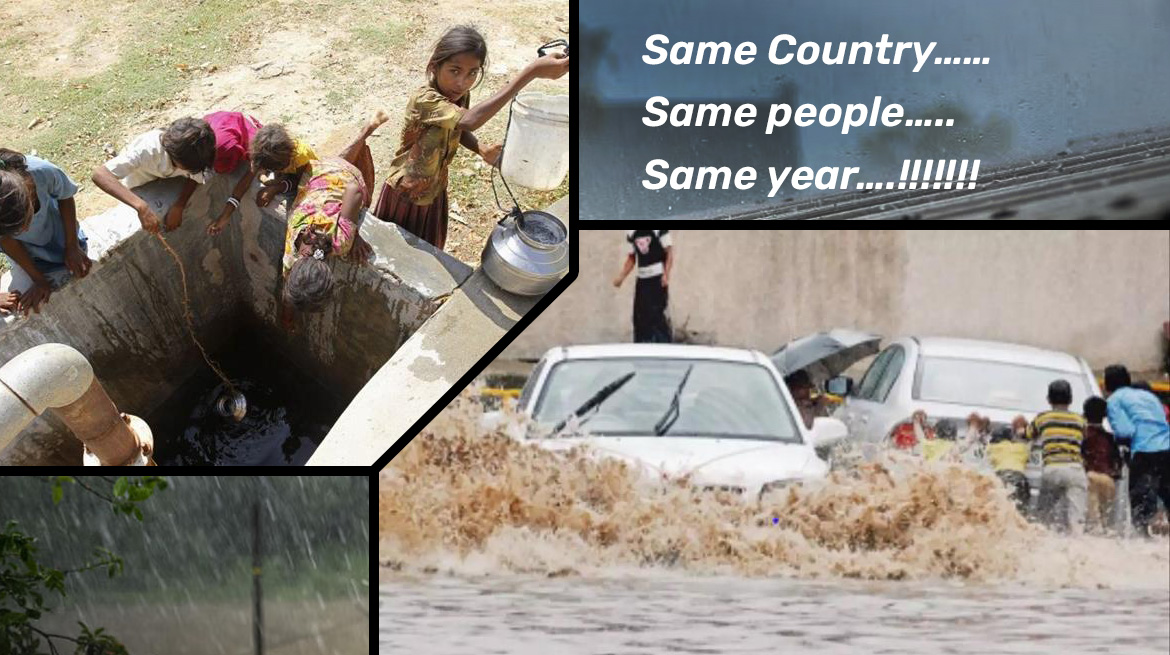Weak water governance, massive reluctance to innovation by locals & their heavy expectations from government leading to hold backs every year, no conservation & diversion of flood flows are leading to water shortages, skewed variability, demands & poor disaster management (flash floods etc) in India causing considerable amount of flood water to just flow down the rivers to ocean leading to poor water holding capacity in reservoirs, aquifers etc.
Sustainable developmental Goals says “Investment in water security helps to drive sustainable growth” but only 8% water is harvested in India. The process of gathering and preserving rainwater for future use is known as rainwater harvesting. This age-old method Dholavira, Gujrat) has become more well-known recently because of its advantages for the economy and ecology.
Rainwater collecting can be used to individual homes or entire towns, depending on the size of the project. The Meteorological Department reports that 1,180 mm of rain falls in India annually on average. In India, only 8% of precipitation is collected.
A family can get up to 70% of its water needs via rainwater gathering. In addition, the government offers financial assistance for rainwater collection systems. Reducing flooding and water pollution can be achieved by rainwater harvesting. Water conservation can be done affordably by using rainwater gathering. It leads to……
Cost Savings: Since collected rainwater can either supplement or completely replace municipal or groundwater supplies, it can result in lower water bills. Energy and expenses related to the delivery and purification of water can also be reduced.
Sustainability of the environment: By collecting rainwater, less stormwater runoff happens, which lowers the risk of flooding and soil erosion. Additionally, it protects nearby water resources and aids in groundwater recharge.
Self-sufficiency: During times of drought or emergency, rainwater collection offers a decentralised water source that enables people and communities to become more self-reliant.
Better plant health: Rainwater is good for irrigation because it is naturally gentle and chemical-free. Rainwater has a neutral pH and vital nutrients, which makes it ideal for watering plants.
Certain common already implemented successful techniques of Rain Water Harvesting (RWH) are:
- Rooftop Rainwater Harvesting.
- Surface Runoff Harvesting.
- Percolation Pits.
- In-Ground Storage Systems.
- Check Dams.
- Contour Bunds
- Rain Gardens.
- Storm water Harvesting.
Conservation practices globally effectively control peak flows and improve water quality, but their effectiveness varies with weather, soil, and cropping systems. They mitigate climate change impacts but decrease with extreme precipitation and increased greenhouse gas concentration.
The methods by which conservation strategies affect flooding and water quality are generally identical, which complicates measuring their performance individually.
Flood Risk = Hazard X Vulnerability
Structural methods like reservoirs/embankments could address the hazard issues whereas Nonstructural methods like forecasting & flood plain zoning could inscribe the vulnerability issues. There are no valid reasons for Indian communities to replace their existing legacy systems of water harvesting.
In 2002, the Keralan town of Alappuzha launched a thorough rainwater collection initiative. The project included building ponds, recharge pits and rooftop rainwater gathering systems. Consequently, the community has experienced a notable rise in groundwater levels, a decrease in water shortages, and an enhancement in the quality of the water.
A community in Maharashtra called Ralegan Siddhi went from being a drought-prone area to becoming a utopian role model for sustainable water management. Leading the charge was famed social activist Anna Hazare. The village installed check dams, percolation tanks and rooftop catchment systems, among other rainwater collection methods. Due to these initiatives, groundwater levels have significantly increased and the neighbourhood now has year-round access to water.
A severe water shortage existed in Jaisalmer, a city in Rajasthan’s dry region. The community widely adopted rainwater collection as a solution to this problem. To collect and store rainwater, they built subterranean water storage tanks known as “Tanka.” Stone and mortar, which are readily available in the area, are used to construct these tanks. The programme has made it possible to guarantee water availability during the dry season and recharge groundwater.
Similarly Rain Water Harvesting in Kalpana Chayya in Rajasthan, Jagsa village in Barmer Rajasthan, Noida in UP, Rain water harvesting park (BWSSB) in Bangluru, Chennai model, rooftop rainwater harvesting system of Shillong, catch the rain campaign CHHATA of Bhuvneshwar, Indore municipal corporation rooftop rain water harvesting systems are in clover.
Advisory from Ministry of Jal Shakti envisages strict guidelines of Do’s & Dont’s to implement scientifically while installing any rain water harvesting system to avoid potential contamination etc.




